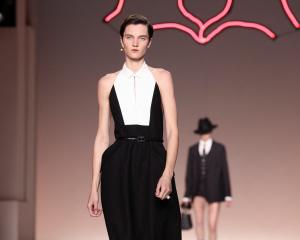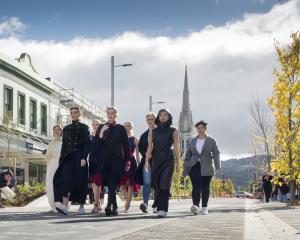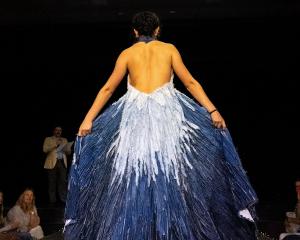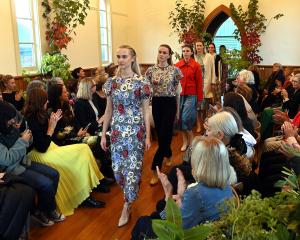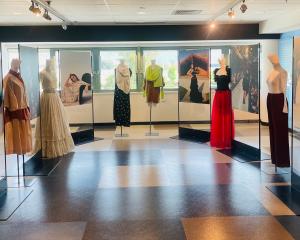The uniforms for the 1974 British Commonwealth Games victory hostesses provide a lesson in fashion design, writes Gavin O'Brien.
In late1973, a young New Zealand fashion designer, Jane Daniels, was announced the winner of a nationwide competition for the design of the ''victory hostess'' uniforms to be used at the 1974 British Commonwealth Games in Christchurch the following summer.
The role of these hostesses was pivotal in the plan for ''The Games'' (as they were popularly known), as the victory hostesses were to carry the medals out to the victory ceremonies following the final of each event.
Applications to perform the role poured in from young women throughout the country.
Among the victory hostesses eventually selected was Oamaru teenager Chris Garey, who later described her role as ''the experience of a lifetime''.
She maintained a strong link to the experience by taking up the opportunity to purchase her uniform immediately after the Games and has preserved it carefully for more than 40 years.
Now a resident of Broad Bay, Garey has enthusiastically presented her Games experience on numerous occasions to Dunedin design students.
But what lay behind Daniels' success?
To those who knew of her, it was probably not a great surprise.
Her competition-winning entry was yet another triumph in the 20-year-old's burgeoning career as a fashion designer and followed a string of such successes over the previous four years.
These included two successive wins in the prestigious Apparel Cup, and three New Zealand Fashion Showcase awards, one of these a design for a Miss New Zealand gown to be worn on the international stage.
As for the design itself, Daniels' ''total look'' for the victory hostesses' uniform teamed perfectly with the stylised modernism of Colin Simon's iconic games symbol, and was the outcome of a well-grounded yet inspired approach to the competition brief.
Her ''rationale of entry'' submitted to the competition, carefully outlined the core priorities of her design; it could well serve as a master class in strategic thinking.
In discussing her priorities Daniels took what may seem a surprising approach for a fashion designer by ranking practicality ''most important of all'', noting that ''some venues may be windy and both hands of the victory hostess will be holding the victory cushion''.
This clear-headed understanding of the physical context for which she was designing is again evident when she later notes that ''The garment must be practical, distinctive, and easily recognisable from a distance''.
In this regard she demonstrated a strong understanding of the role that colour would play in her design by rejecting the use of colour prints that ''would blur into colours other than those of The Games when seen at a distance''.
Here she stipulated that ''white should predominate'', in order that the victory hostesses could be easily distinguished from the uniforms of the officials and also ''stand out from the brown of the track and the green of the inner stadium''.
This was no small consideration for this particular event.
The Games were to be broadcast live and for the first time New Zealanders would be viewing them on colour television, a new technology in homes around the country.
Uniformity was also an essential quality of Daniels' design intentions and led to her decision that the hostesses would be more suitably kitted out in trousers rather than skirts.
''It became evident that trousers would present a neat unbroken line'' she reasoned, ''whereas the heights of the victory hostesses would differ slightly, thus varying skirt lengths and presenting not as tidy a picture''.
''Trousers'', Daniels also successfully argued, ''were acceptable as both day and evening wear''.
Even the belt buckles were custom-designed as part of her ''total look''.
A further priority of Daniels' planning was the task of ensuring that ''The garment must be representative of New Zealand'' and in addressing this, she turned to Maori culture for a cue noting, ''I had only to look at Maori history and culture for inspiration ... thus the modern representation of the traditional feathered cloak worn by Maori chieftains appears as the short cape''.
Daniels' cogent rationale was accompanied by a number of highly accomplished sketches which combined to persuade the judges to award her the $250 first prize and see her designs feature as a production highlight of the Christchurch Games.
The uniforms were manufactured by Christchurch's Cantwell Creations, which was also the sponsor of the victory hostess design competition.
Shortly after the Christchurch Games, Daniels travelled to London where she spent several years developing her career as a fashion designer.
This included an intensive year of training at the prestigious private fashion school founded by acclaimed pattern maker Natalie Bray.
After returning to New Zealand she established her own Auckland-based label, Jane Daniels, which continues to feature as a leading New Zealand fashion design label.
• Gavin O'Brien is a senior lecturer in product design at Otago Polytechnic School of Design


